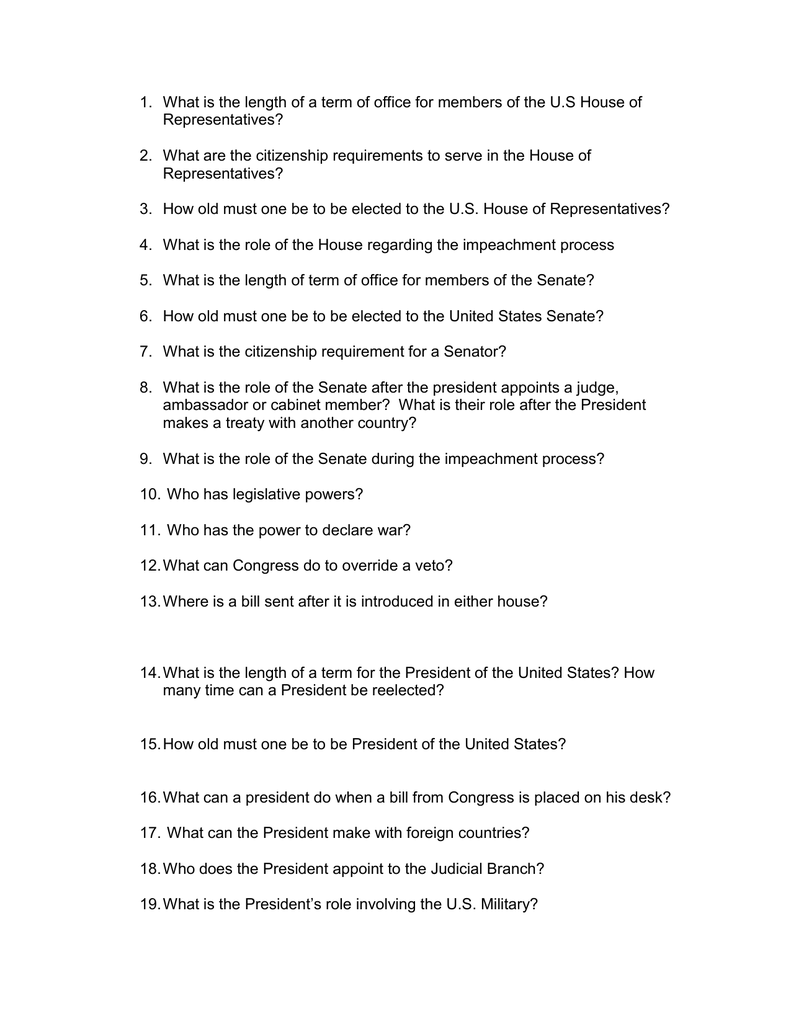Table Of Content

There are also select and special committees, which are usually appointed for a specific project and for a limited period. Legislative term limits can be either lifetime or consecutive. In the ten states where the limits are consecutive, once a state legislator has served the maximum number of terms in office, he or she, if eligible, can run for office for the state's other legislative chamber, or leave the legislature. These states are Arizona, Arkansas, Colorado, Florida, Louisiana, Maine, Montana, Nebraska, Ohio, and South Dakota. After a period of time no longer in office in a particular legislative chamber, however, the legislator is allowed to run again for office in that legislative chamber.
Five reasons to oppose congressional term limits Brookings - Brookings Institution
Five reasons to oppose congressional term limits Brookings.
Posted: Thu, 18 Jan 2018 08:00:00 GMT [source]
HISTORY Vault
Representatives of the House are addressed as “The Honorable,” before their names, or as congressman, congresswoman, or representative. Their goal was to design a form of government that would keep one person or group of people from having too much power, or unchecked power. As a result, the two chambers are considered equal, even though they have different structures and roles.
Homeless encampments are on the ballot in Arizona. Could California, other states follow?
Presently, the District of Columbia and the five inhabited U.S. territories each elect a delegate. A seventh delegate, representing the Cherokee Nation, has been formally proposed but has not yet been seated.[30] An eighth delegate, representing the Choctaw Nation is guaranteed by treaty but has not yet been proposed. Additionally, some territories may choose to also elect shadow representatives, though these are not official members of the House and are separate individuals from their official delegates.
Leadership
House leadership includes the speaker, majority and minority leaders, assistant leaders, whips and a party caucus or conference. The speaker acts as leader of the House and combines several institutional and administrative roles. Majority and minority leaders represent their respective parties on the House floor. Whips assist leadership in managing their party's legislative program on the House floor.

Each of the two political parties also elect a “Whip”—the Majority Whip for the party with the most seats, and the Minority Whip for the other party—from their House delegations. The whip’s official role is to count potential votes for bills being debated for the party leaders. The House Majority Leader—who is also chosen from among the membership of the political party with the most seats in the House—schedules time for floor debate on legislation and sets the legislative strategy for the party in control. Each state is guaranteed at least one member of the House of Representatives. The allocation of seats is based on the population within the states, and membership is reapportioned every 10 years, following the decennial census. House members are elected for two-year terms from single-member districts of approximately equal population.
Passage of legislation
The makeup of the Rules Committee has traditionally been weighted in favor of the majority party, and has been in its current configuration of 9 majority and 4 minority members since the late 1970s. The Rules Committee controls what bills go to the House Floor and the terms of debate. Curious about who else has been Speaker of the House or Majority Leader? View the list of leadership offices and links to the websites. To be elected, a representative must be at least 25 years old, a United States citizen for at least seven years and an inhabitant of the state he or she represents. The president may veto a bill passed by the House and Senate.
U.S. House Committees
The Speaker of the House is also the second person in the U.S. presidential line of succession—the order in which presidents are replaced if they die, resign or are removed from office—after the Vice President and before the President pro tempore of the Senate. In contrast, term lengths of state senators are generally longer. In the remaining eight states, senators serve one two-year term and two four-year terms every ten years in the term system. A senator must be at least 30, a U.S. citizen for at least nine years, and live in the state he or she represents.
118th Congress has more veterans, but still few by historical standards - Pew Research Center
118th Congress has more veterans, but still few by historical standards.
Posted: Wed, 07 Dec 2022 08:00:00 GMT [source]
Other lawmakers pointed to the importance of knowing the history of past legislation that has been considered by the Missouri House or Senate, arguing that knowledge of what killed a bill in the past is crucial in advancing it in the future. “If we had put parentheses out around the eight and eight and stricken those, we would have what this measure calls for, which is 16 years total service in either or both houses,” Stephens said. The Missouri House gave preliminary approval to a bill that would allow legislators to serve a total of 16 years in either chamber of the Missouri General Assembly. COVID-19 rent relief is still available from the state on a first-come, first-served basis and covers 100% of rent and utilities. In L.A. County during the pandemic, tenants are protected from some standard causes for eviction, such as unauthorized pets or an unauthorized long-term guest whose presence is related to the pandemic, or for causing a nuisance or denying entry to a landlord.
The House is also served by several officials who are not members. The House's chief such officer is the clerk, who maintains public records, prepares documents, and oversees junior officials, including pages until the discontinuation of House pages in 2011. The clerk also presides over the House at the beginning of each new Congress pending the election of a speaker. Another officer is the chief administrative officer, responsible for the day-to-day administrative support to the House of Representatives.
States entitled to more than one representative are divided into single-member districts. This has been a federal statutory requirement since 1967 pursuant to the act titled An Act For the relief of Doctor Ricardo Vallejo Samala and to provide for congressional redistricting.[18] Before that law, general ticket representation was used by some states. Stephens reason for proposing the change is that he thinks the short term limit in each chamber causes the loss of a lot of institutional knowledge held by experienced legislators. The 435 congressional districts do not include the District of Columbia, Puerto Rico, and the U.S.’s four other island territories — American Samoa, Guam, the Northern Mariana Islands, and the U.S. Virgin Islands — which each send a non-voting delegate to the House. Puerto Rico’s delegate is called the Resident Commissioner.
California’s COVID-19 eviction moratorium expired Thursday, but there are still some protections in place for tenants whose finances were affected by the pandemic. In its original form, Article IV of the 1879 California Constitution structured the legislature in a similar way to the 1849 Constitution. However, the 1879 Constitution explicitly stated that the Senate has 40 members and that the Assembly has 80 members.[11] The constitution also explicitly provides that Senators terms are four years and the terms of members of the Assembly are two years. 32% of representatives are men over the age of 60, while only 17% of representatives are women 60 years old or younger.
The chaplain leads the House in prayer at the opening of the day. The sergeant at arms is the House's chief law enforcement officer and maintains order and security on House premises. Finally, routine police work is handled by the United States Capitol Police, which is supervised by the Capitol Police Board, a body to which the sergeant at arms belongs, and chairs in even-numbered years.
Senators are elected to six year terms and may be reelected indefinitely. Congress is to limit the total amount of time a senator may serve to a lifetime 12-years and house reps to a lifetime of 6-years. The total amount of time they would be permitted to serve is 18-years of their lifetime. The House’s standing committees have different legislative jurisdictions. Each considers bills and issues and recommends measures for consideration by the House.
The Constitution vests certain exclusive powers in the House of Representatives, including the right to initiate impeachment proceedings and to originate revenue bills. The organization and character of the House of Representatives have evolved under the influence of political parties, which provide a means of controlling proceedings and mobilizing the necessary majorities. Party leaders, such as the speaker of the House and the majority and minority leaders, play a central role in the operations of the institution. From 1910 to 1975 committee and subcommittee chairmanship was determined purely by seniority; members of Congress sometimes had to wait 30 years to get one, but their chairship was independent of party leadership. The rules were changed in 1975 to permit party caucuses to elect chairs, shifting power upward to the party leaders.

No comments:
Post a Comment